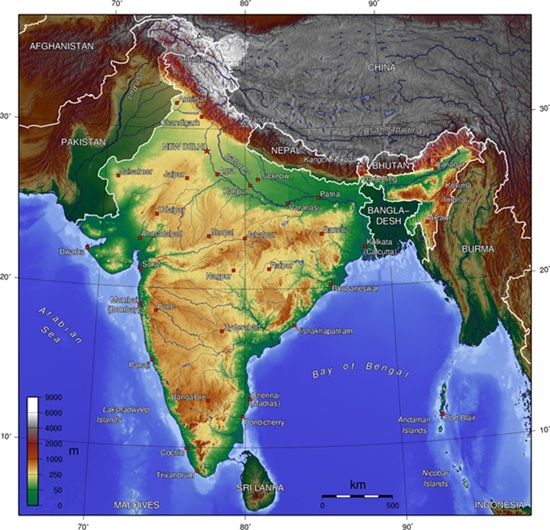| (UPSC Mains — GS Paper 3: Environment) |
The Indian Himalayan Region (IHR) is not only the ecological backbone of India but also the lifeline of Asia. Stretching from the high altitudes of the Himalayas to the hilly terrains of the northeastern states, this region sustains millions of lives, cultures, and water resources. However, climate change, unplanned development, tourism pressure, and ecological imbalance have emerged as serious threats.
In recent times, some landmark Supreme Court judgments have introduced new hope in this direction. The Court has declared that freedom from the adverse effects of climate change is a fundamental right, protected under Article 14 (Right to Equality) and Article 21 (Right to Life) of the Constitution.

Major Supreme Court Judgments
- M.K. Ranjit Singh vs Union of India (2024) : The Supreme Court recognized the right to live free from the adverse effects of climate change as a fundamental right under Articles 14 and 21.
- Ashok Kumar Raghav vs Union of India (2023) : The Court directed the Centre and the petitioner to suggest measures for sustainable development based on the carrying capacity of Himalayan towns and states.
- State of Telangana vs Mohammad Abdul Kasim (2023) : The Court emphasized the need for an ecocentric approach in environmental matters, where nature remains at the center of all decisions.
Significance of the Indian Himalayan Region
- Water Tower of the Earth: The glaciers of the Himalayas feed Asia’s major rivers — Ganga, Brahmaputra, Indus, etc. — sustaining around 1.4 billion people.
- Climate Regulator: The Himalayas act as a climatic barrier, blocking icy winds from the Arctic and influencing the direction and intensity of the monsoon.
- Biodiversity Hotspot: Two of India’s four biodiversity hotspots — the Himalayas and Indo-Burma — are located here.
- Natural Resource Hub: Rich in morel mushrooms (Gucchi), medicinal plants, wildlife, forests, and freshwater resources.
- Carbon Sink: Himalayan forests store approximately 5.4 billion tons of carbon, contributing significantly to India’s carbon neutrality goals.
Major Challenges
-
Deforestation and Habitat Loss: Between 2019–2021, Himalayan states lost around 1,072 sq km of forest cover.
-
Rapid Glacier Retreat:
- The Gangotri glacier has retreated nearly 1,700 meters between 1935–2022.
- The formation of glacial lakes has increased the risk of Glacial Lake Outburst Floods (GLOFs).
-
Tourism Pressure: Around 100 million tourists visit IHR annually; projected to reach 240 million by 2025. Towns like Joshimath, Shimla, and Mussoorie are already exceeding their carrying capacity.
-
Unsustainable Infrastructure Growth: Unscientific construction on fragile slopes, reckless road widening, and tunnel projects have intensified landslides, water scarcity, and subsidence.
Way Forward
- Creation of a ‘Himalayan Authority’: A constitutional body for ecological coordination, policy planning, and monitoring across all Himalayan states.
- Smart Mountain Tourism: Implement eco-certification-based tourism policies and introduce a Green Cess to promote environmental taxation.
- Revival of Local Springs: Expand models like Sikkim’s Dhara Vikas Yojana to rejuvenate natural springs throughout the Himalayas.
- Distinct Environmental Impact Assessment (EIA): Formulate separate EIA standards for the Himalayas, considering geological sensitivity and fragile ecosystems.
- Community Participation and Capacity Building: Empower local mountain communities as active partners in conservation and sustainable livelihoods.
Conservation Initiatives
National Initiatives:
- National Mission on Sustaining the Himalayan Ecosystem (NMSHE)
- Centre for Cryosphere and Climate Change Studies
- Swadesh Darshan Scheme: Promoting eco-tourism and waste management.
Global Initiatives:
- International Centre for Integrated Mountain Development (ICIMOD)
- SECURE Himalaya Project: Funded by the Global Environment Facility (GEF) for wildlife conservation and combating illegal trade.
Conclusion
The Indian Himalayan Region is the ecological soul of India. Land-use changes, illegal mining, forest fires, wildlife trafficking, and climate change are critically destabilizing this region’s balance. Judicial interventions have now reinforced that climate justice and environmental rights are permanent fixtures within India’s constitutional framework.
Hence, it is imperative to:
- Maintain balance between development and conservation,
- Formulate a dedicated Himalayan policy framework, and
- Transform sustainable development from a slogan into a practice.
“Protecting the Himalayas is protecting India.” The preservation of the Himalayas is not just an environmental issue — it is a question of the very survival of future generations.


